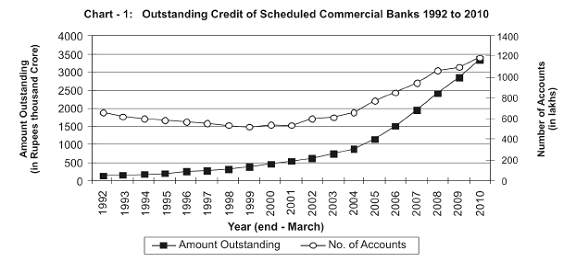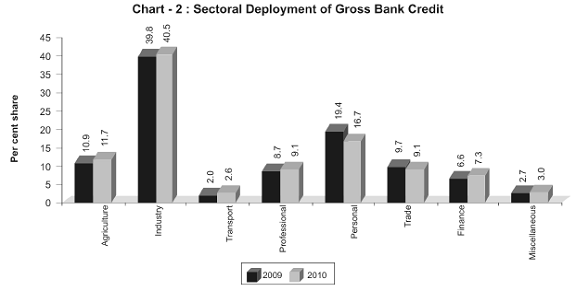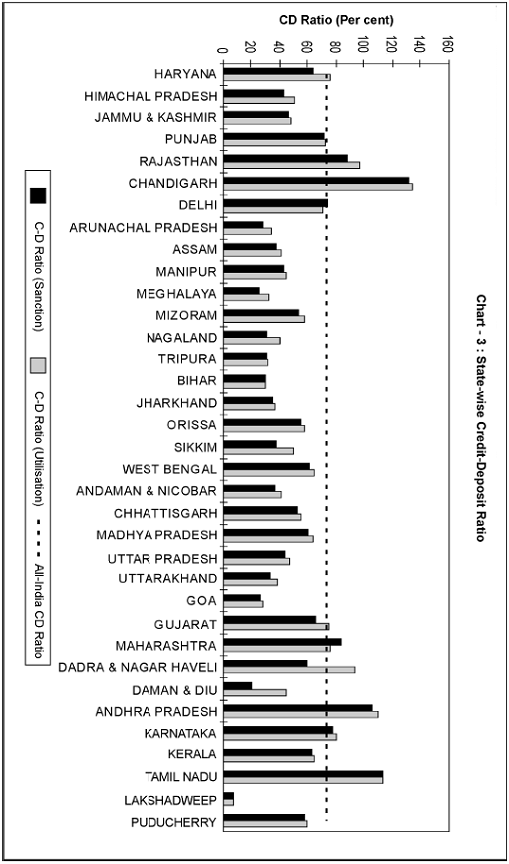Highlights
1. The Basic Statistical Returns of Scheduled Commercial Banks in India, is based on data
collected through BSR 1 and 2 surveys as on March 31, 2010, which covered 86,960
offices of scheduled commercial banks including regional rural banks. These returns are
collected from each branch/office of a scheduled commercial banks in India. The salient
features are set out below:
Outstanding Credit of Scheduled Commercial Banks:-
2. Growth of gross outstanding credit:
-
At the end of March 2010 gross outstanding credit of scheduled commercial banks amounted
to ` 33,45,169 crore registering an increase of 17.5 per cent as against an increase of 17.8
per cent in the previous year (Table No.1.3).
-
The number of borrowal accounts increased to 11.9 crore in 2010* from 11.0 crore in
2009*, i.e. by 7.8 per cent (Table No. 1.3).
3. Bank group-wise distribution of credit:
-
The share of the nationalised banks in total bank credit is more than half, showing an
increase to 52.0 per cent in 2010 from 50.5 per cent in 2009. The share of ‘private sector
banks’ was 17.5 per cent in 2010. The share of foreign banks declined to 4.9 per cent in
2010 from 5.9 per cent a year ago (Table No.1.4).
-
The regional rural banks had the highest credit growth at 23.8 per cent in 2010 followed by
the nationalized banks which recorded a growth of 21.0 per cent. The SBI & Associates
and Private sector banks witnessed growth in credit at 17.7 and 12.9 per cent in 2010,
respectively. Foreign banks recorded a credit decline of 1.6 per cent.
-
Of the incremental credit, during 2010, SBI & Associates, Nationalised banks and
private sector banks shared 23.4 per cent, 60.5 per cent and 13.4 per cent,
respectively.
4. Sectoral (occupation wise) deployment of bank credit:
-
The share of agriculture credit in gross bank credit increased to 11.7 per cent from 10.9
per cent in 2009. The share of credit to industry increased to 40.5 per cent in 2010 from
39.8 per cent in 2009 (Table 1.11 and Chart 2).
-
The share of personal loans decreased to 16.7 per cent of gross bank credit in 2010 from
the level of 19.4 per cent in the previous year.
-
The share of credit to trade decreased to 9.1 per cent in 2010 as against 9.7 per cent in
2009.
5. Sectoral (Occupation wise) credit off-take:
-
The growth rate of bank credit to agriculture increased to 26.1 per cent in 2010 as against
12.9 per cent in the preceding year (Table 1.9).
-
The growth of credit to industry declined to 19.5 per cent in 2010 from 22.2 per cent
recorded in 2009.
-
Personal Loans registered an increment of 1.0 per cent in 2010 compared to 14.0 per cent
in 2009. Housing loans, which forms a part of personal loans increased by 7.6 per cent
compared to 14.6 per cent in the previous year.
6. Incremental Bank Credit (Occupation wise):
-
The industry sector, with 47.8 per cent share in the incremental credit in 2009, continued
to capture the major share in 2010 at 44.4 per cent.
-
The agriculture sector absorbed about 16.3 per cent of the incremental credit in 2010
compared to 8.2 in 2009.
-
The personal loans accounted for 1.1 per cent of incremental credit compared to 15.8 per
cent registered in the previous year. Housing loans accounted for 4.3 per cent compared
to 8.4 per cent registered in the previous year.
-
The share of credit to professionals in the incremental credit at 11.4 per cent declined
from 14.2 per cent recorded in 2009.
7. Size-wise distribution of bank credit:
-
The number of small borrowal accounts (with credit limit up to ` 2 lakh) contributed to 86.5
per cent of total number of accounts as against 87.0 per cent in 2009, while the share of
outstanding credit of small borrowal accounts was 10.8 per cent as compared to 12.3 in
2009 (Table No.1.12).
-
Accounts with credit limit above ` 25 crore each contributed to 43.7 per cent of the
outstanding credit in 2010 and it increased from 41.2 per cent observed in the previous year.
8. Interest rate on bank credit:
-
The distribution of outstanding credit according to interest rate ranges (available for accounts
each with credit limit of over ` 2 lakh) revealed that the proportion of outstanding amount
was the highest at 63.7 per cent in the range of 6 – 12 per cent (Table No. 1.13).
-
The weighted average interest rate in respect of all loans and advances with credit limit of
over ` 2 lakh worked out to be 10.5 per cent as at the end of March 2010 as compared to
11.5 per cent in the previous year.
Aggregate Deposits:-
9. Growth in aggregate deposits:
-
Aggregate deposits amounted to ` 45,61,029 crore registering a growth of 16.3 per cent in
2010 as against 20.7 per cent a year ago (Table No.1.18).
-
The number of deposit accounts in 2010 increased by 11.0 per cent to 73.5 crore from
about 66.2 crore in March 2009.
10. Bank group-wise distribution of deposits:
-
The nationalised banks have a major share in aggregate bank deposits, at 51.9 per cent in
2010. The share of SBI & Associates declined to 22.3 in 2010 as compared to 24.1 per
cent in 2009 (Table No.1.4).
-
The deposits of the Nationalised banks registered the highest growth of 22.1 per cent
followed by the Regional Rural Banks (19.8 per cent) and Private Sector Banks (12.9 per
cent) in 2010.
11. Type of deposits:
- The share of term deposits in total deposits decreased to 60.8 per cent in 2010 from 63.5 per
cent in 2009. The shares of current deposits and saving deposits are at 12.2 per cent and
27.0 per cent, respectively in 2010 as against 12.0 and 24.5 per cent in 2009 (Table No.1.18).
12. Maturity pattern of term deposits:
-
The share of term deposits with original maturity period of 5 years and above in total term
deposits increased to 8.3 per cent in 2010 from 7.6 per cent in the previous year. Also
deposits for maturity period 2 to 3 years witnessed increase in its share to 12.3 per cent
from 10.6 per cent in the previous year. (Table No.1.24).
-
The share of term deposit with maturity period 1 to 2 years declined to 37.9 per cent in
2010 from 41.5 per cent in 2009.
13. Interest rate on term deposits:
- The weighted average interest rate of term deposits worked out to 7.0 per cent in 2010, as
compared to 8.8 per cent as at end-March 2009 (Table No.1.28).
14. Interest rate spread:
- The interest rate spread on bank credit (large borrowal account with credit limit over ` 2
lakhs) over term deposits was at 3.6 per cent in 2010 compared to 2.6 per cent in 2009.
Credit - Deposit Ratio:-
(As per Place of Sanction and Utilisation of Credit)
15. Population group-wise C-D Ratio:
-
The All-India C-D ratio was at 73.3 per cent in 2010 compared to 72.6 per cent in 2009.
-
The population group-wise C-D ratio in respect of rural areas at the end of March 2010 was at
59.3 per cent as per place of sanction of credit. In the case of semi-urban and urban areas the
C-D ratios were 52.1 per cent and 59.1 per cent, respectively. The C-D ratios as per place of
utilisation for rural, semi-urban and urban areas were 91.6 per cent, 59.9 per cent and 62.8 per
cent, respectively. The C-D ratio recorded in metropolitan centers as per place of sanction and
utilisation was 85.9 per cent and 77.4 per cent respectively in 2010 (Table No.1.6).
16. Migration of credit among the states:
-
The analysis of migration of credit among the states has been done through the Credit
Deposit ratios, calculated as per the place of sanction of credit and place of utilisation of
credit (Table No. 1.7 and Chart –3).
-
Rajasthan, Chandigarh, Maharashtra, Andhra Pradesh, Karnataka and Tamil Nadu had
C-D Ratio, both as per place of sanction and utilization, above the All-India C-D Ratio
(73.3 per cent).
-
Among these states Chandigarh, Rajasthan, Andhra Pradesh and Karnataka had higher
C-D ratios as per utilisation than sanction.
* All references to the periods 2010 and 2009 will mean position as at the end of March 2010 and March 2009 respectively. |

























